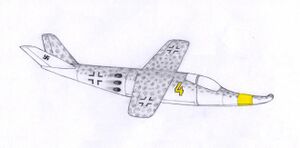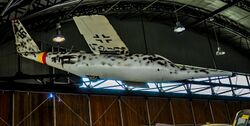Engineering:Zeppelin Fliegende Panzerfaust
| Fliegende Panzerfaust | |
|---|---|

| |
| Role | Very-short-range interceptor |
| National origin | Germany |
| Manufacturer | Zeppelin |
| Primary user | Luftwaffe |
| Number built | One mock-up built |
| Developed from | Zeppelin Rammer |
The Fliegende Panzerfaust, meaning 'flying tank fist' (literally 'Flying Armor Fist') in the German language, was a project for a Third Reich very-short-range interceptor designed by Luftschiffbau Zeppelin.
The Fliegende Panzerfaust project was part of the Nazi propaganda-based Wunderwaffe ('wonder weapon') concept. It was proposed to the Emergency Fighter Program against the allied bombing raids over Nazi Germany in the last years of World War II.[1]
Description
The Fliegende Panzerfaust was a rocket-powered design meeting the demand for a low-cost aircraft in a very-short-range interceptor role. It was a parasite aircraft meant to be towed behind a Messerschmitt Bf 109G for which it had a special long, "up-turned" nose for towing.[citation needed] Powered by six Schmidding SG 34 solid-fuel rocket engines, three on each side on the rear half of the fuselage, the Fliegende Panzerfaust was a small aircraft with an armored nose, a v-tail, a wingspan of 4.5 m and a length of 6.0 m.[2]
This Zeppelin-built aircraft would have been released upon reaching combat altitude above the enemy bomber fleet. Shortly before contact with the combat box below it would ignite its engines, attacking the target bomber by firing two 73 mm RZ 65 air-to-air missiles at extremely close range.[3]
Since after expending the fuel the center of gravity would have shifted substantially, making the aircraft too difficult to handle, the front half of the Fliegende Panzerfaust, which had the pilot lying in a prone position, would then separate from the other half.[1] Both parts would land separately using parachutes, being later retrieved and reused. Owing to the extreme risks for the pilot inherent in its operation this aircraft is sometimes referred to as a suicide weapon.[4]
Specifications
Data from Dieter Herwig & Heinz Rode, The Luftwaffe Secret Projects: Ground Attack & Special Purpose Aircraft. Midland Counties Publ. ISBN:978-1857801507
General characteristics
- Crew: one
- Length: 6.0 m (19 ft 8 in)
- Wingspan: 4.50 m (14 ft 9 in)
- Height: 1.50 m (4 ft 11 in)
- Gross weight: 1,200 kg (2,646 lb)
- Powerplant: 6 × Schmidding SG 34 solid-fuel rocket engines, 4.9 kN (1,100 lbf) thrust each - total weight 150 kg
Performance
- Maximum speed: 850 km/h (530 mph, 460 kn)
Armament
- Rockets: 2 RZ 65
Replicas
There is a Fliegende Panzerfaust replica on display at the Military Aviation Museum in Virginia Beach, Virginia.[5][6]
See also
- Emergency Fighter Program
- Panzerfaust
Aircraft of comparable role, configuration and era
- Bachem Ba 349
- Blohm & Voss P 214
- DFS Eber
- Zeppelin Rammer
- Focke-Wulf Volksjäger
Related lists
- List of German aircraft projects, 1939–45
- List of rocket aircraft
- List of World War II Luftwaffe aircraft prototype projects
Bibliography
- Manfred Griehl & Joachim Dressel, Die Deutschen Raketenflugzeuge 1935-1945: Die Entwicklung einer umwalzenden Technik, Weltbild, ISBN:3613012766
References
- ↑ 1.0 1.1 Ulrich Albrecht. "Artefakte des Fanatismus; Technik und nationalsozialistische Ideologie in der Endphase des Dritten Reiches". Wissenschaft & Frieden 1989-4. http://www.wissenschaft-und-frieden.de/seite.php?artikelID=0833.
- ↑ The Fliegende Panzerfaust (Flying Armored Fist). Another Desperate Attempt To Stop The Inevitable
- ↑ Allgemeine Luftkampfraketen
- ↑ German Suicidal Aircraft
- ↑ "Fliegende Panzerfaust 'Flying Bazooka', Military Aviation Museum, Virginia Beach - a photo on Flickriver". http://www.flickriver.com/photos/petercookuk/18408399312/.
- ↑ "mam_warbirds_program_2016". issuu. https://issuu.com/militaryaviationmuseum5/docs/mam_warbirds_program_2015/45.
External links
 |


